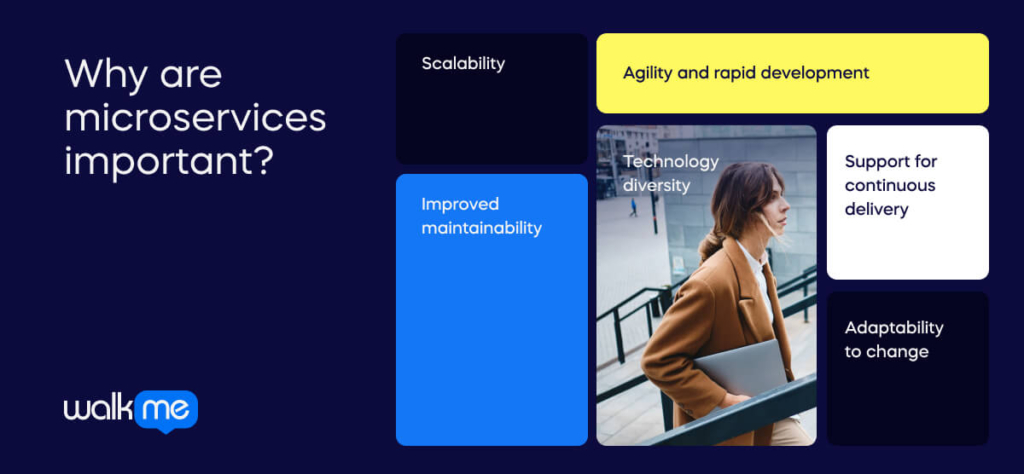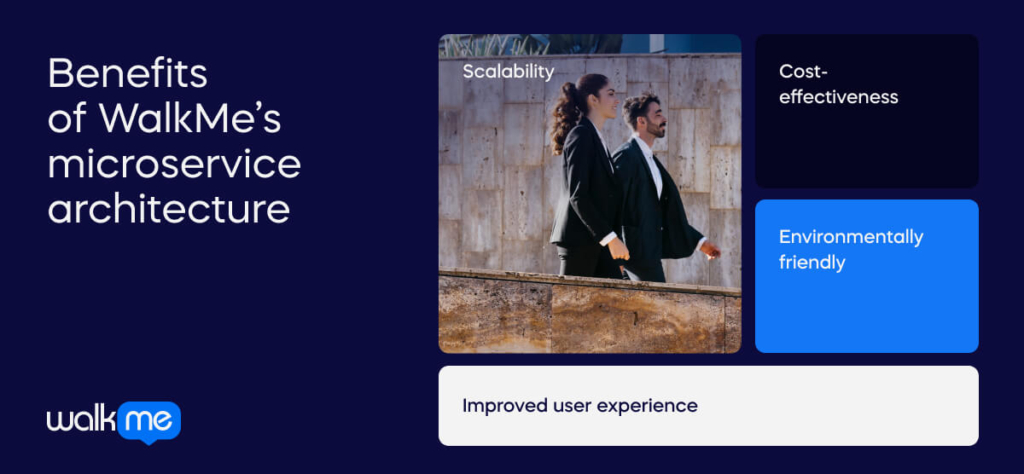Table of Content
In a microservices architecture, the application is divided into smaller, self-contained services that communicate through well-defined APIs (Application Programming Interfaces).
Each microservice is responsible for a specific business function and can be developed and deployed independently of other services. This approach allows for greater flexibility, scalability, and maintainability than traditional monolithic architectures.
Microservices’ modular and independent nature aligns well with the dynamic requirements of organizations seeking effective digital adoption strategies.
They fit well into the overarching goals of businesses seeking to invest more in transformative IT infrastructure. Indeed, IT spending in Europe is projected to total $1.1 trillion in 2024, an increase of 9.3% from 2023, according to research by Gartner.
Microservices seek to upgrade traditional architectures, which provide less flexibility.
Businesses recognize the benefits, as evidenced by the forecasted growth of the application modernization services market to USD 32.8 billion by 2027.
By promoting modular development, independent scalability, and rapid deployment, microservices empower the workforce to drive innovation, enhance productivity, and deliver cutting-edge solutions, fostering a dynamic and forward-thinking business environment.
Why are microservices important?

Microservices play an integral part in the development of digital services. Here are just a few ways they transform the space:
Scalability
Microservices enable horizontal scaling, allowing organizations to scale individual services independently based on demand.
This provides a more efficient use of resources and ensures that only the necessary components are scaled, rather than the entire application. Scalability is crucial for handling varying workloads and accommodating growth.
Agility and rapid development
Microservices promote agility by allowing teams to work on and deploy individual services independently.
This speeds up the development process, as teams can focus on specific features or functionalities without being constrained by the development and release cycle of the entire application. Rapid development is essential in today’s fast-paced business landscape.
Improved maintainability
Microservices make it easier to maintain and update systems. Since each service has a specific responsibility and is independent of others, changes or updates can be made to one service without affecting the entire application.
This modularity simplifies maintenance tasks, making debugging, enhancing, and deploying updates more straightforward.
Technology diversity
Microservices allow for technology diversity within an application. Different services can be developed using different programming languages, frameworks, and databases based on specific requirements.
This flexibility enables organizations to choose the best tools for each job, fostering innovation and using specialized technologies.
Support for continuous delivery
Microservices are well-suited for continuous delivery and deployment practices. Since services can be developed and deployed independently, organizations can implement a continuous integration/continuous deployment (CI/CD) pipeline more effectively.
This allows for quicker and more frequent releases of new features and updates.
Adaptability to change
Microservices provide a modular architecture that facilitates adaptability to changing business requirements. Organizations can easily add, modify, or remove services based on evolving needs. This adaptability is crucial in dynamic business environments where the ability to respond quickly to market changes is a competitive advantage.
Benefits of WalkMe’s microservice architecture

Microservices play a crucial role in the WalkMe framework, driving both organizational success and overcoming unique challenges. Here’s how:
Scalability
Microservices architecture transforms complex systems into smaller services that are easier to manage. The architecture also becomes easier to scale and more inherently flexible.
WalkMe took this approach when splitting large sections of their monolith structure into microservices.
For example, one of the features of the DAP is a Smart Walk-Thru, which provides on-screen guidance when users need it to complete tasks.
With microservices forming part of their platform architecture, WalkMe can scale based on customer demand. So, if there was suddenly an influx of demands to use the feature, the inherently scalable architecture can meet it instantly.
Cost-effectiveness
Just as WalkMe can provide more instances to meet demand, the platform can also scale down when needed.
If the Smart Walk-Thru were being used to a lesser extent, the microservice instances would drop to ease the load.
From a business perspective, the main benefit of dynamic scale-down is cost-effectiveness – WalkMe only pays for the resources it uses in a given timeframe by utilizing microservices. Indeed, the payment structure of cloud providers is based on resource allocation.
Environmentally friendly
By migrating to microservices, WalkMe is no longer forced to pay for the maximum amount of resources they need by anticipating user demand and continually running the resources.
Instead, they can scale down during less-intensive usage periods and avoid wasting resources – which is better for the environment.
Improved user experience
A risk of using the traditional monolith architecture is underestimating the needed resources. If there are excess demands and insufficient instances to meet the requests, the user experience will be negatively impacted.
In a best-case scenario, the experience would be slower due to users being forced to share the resource. It’s like being forced to share a textbook with several other people in class but having to take turns reading different pages.
If the resource is truly stretched, the users would be put in a queue and forced to wait, which would cause frustration.
These poor outcomes won’t happen with microservices. As a result, WalkMe prioritizes user experience and creates a frictionless environment for customers due to its architecture migration.
Use cases for microservices
Microservices can be used in a myriad of business environments. Here’s an overview of the practical applications they have.
Microservices in business
Several business types can benefit from microservices:
E-commerce platforms
In e-commerce, microservices can be employed to handle various aspects such as product catalog, user authentication, payment processing, and order fulfillment.
These functionalities can be implemented as independent microservices, allowing for rapid development and updates without disrupting the entire system. For instance, a team can improve the recommendation engine without affecting the checkout process.
Financial services
In the financial sector, microservices can be utilized to create modular components for transactions, customer account management, fraud detection, and reporting.
This approach allows financial institutions to independently scale services based on demand and implement changes to specific functionalities without impacting the entire financial ecosystem.
Healthcare systems
Healthcare applications can benefit from microservices by dividing functionalities such as patient records, appointment scheduling, billing, and prescription management into independent services.
This enables healthcare providers to integrate new features easily, scale services based on patient load, and ensure critical functionalities operate autonomously.
Travel and hospitality
Booking platforms in the travel industry can leverage microservices to handle distinct features like flight reservations, hotel bookings, and car rentals as separate services.
This modular architecture enhances the ability to introduce new offerings, update pricing models, and optimize specific services without affecting the overall functionality of the travel platform.
How businesses find success with microservices
Here are three examples of organizations that have successfully adopted microservices and how they leverage them for their digital adoption strategy:
Netflix: Scalability and personalization
Netflix is a prime example of a company that has effectively utilized microservices to enhance its digital adoption strategy.
The streaming giant employs a microservices architecture to handle different aspects of its platform, such as user authentication, content delivery, and recommendation algorithms.
Netflix achieves enhanced scalability by breaking down its monolithic structure into smaller, independent services.
During peak times, specific microservices can be scaled independently, ensuring a seamless streaming experience for millions of users worldwide.
This has resulted in improved user satisfaction, reduced downtime, and the ability to efficiently handle a growing user base.
Uber: Agility and continuous deployment
Uber, the ride-hailing and food delivery service, has successfully implemented microservices to achieve agility and continuous deployment.
The company’s microservices architecture allows different teams to work on independent services, enabling faster development cycles and quicker response to market demands.
Uber can roll out new features or updates without affecting the entire system, reducing the risk of errors and enhancing the overall user experience.
This adaptability has translated into increased productivity, quicker time-to-market, and the ability to swiftly respond to changing business requirements.
Amazon: Fault isolation and innovation
Amazon, one of the world’s largest e-commerce and cloud computing companies, utilizes microservices to isolate faults and drive innovation.
Amazon’s microservices architecture enables the independent development and deployment of various services, ensuring that a failure in one service doesn’t impact the entire system.
This fault isolation enhances system resilience and minimizes downtime.
Additionally, Amazon leverages microservices to foster innovation by allowing small, specialized teams to work on specific services.
This decentralization of development teams encourages experimentation and accelerates the introduction of new features, ultimately leading to an improved and innovative customer experience.
Microservices vs. monolithic architecture
Microservices and monolithic architecture are two different approaches to designing and building software applications.
Each has its own set of advantages and disadvantages, and the choice between them depends on various factors, such as the project size, the development team’s expertise, scalability requirements, and organizational preferences.
Let’s explore the key characteristics of both microservices and monolithic architecture:
Monolithic architecture
Single unit
Monolithic architecture is characterized by a single, unified codebase that handles all the application’s functionality.
The entire application is deployed as a single unit, making it simpler to develop and initially deploy.
Tight integration
All components and modules are tightly integrated within the same codebase, making it easier to maintain and debug.
Simplicity
Monolithic applications are generally simpler to develop and test, especially for smaller projects or when the application’s functionality is not complex.
Scalability
Scaling a monolithic application involves duplicating the entire application, which may lead to inefficient resource utilization.
Technology stack
The entire application uses the same technology stack, and upgrades or changes often require modifying the entire codebase.
Development speed
Development speed can be faster in the early stages, but as the codebase grows, it may become harder to maintain and extend.
Microservices architecture
Decomposed services
Microservices architecture decomposes the application into smaller, independent services that communicate through APIs.
Each service focuses on a specific business capability.
Loose coupling
Services are loosely coupled, allowing them to be developed, deployed, and scaled independently.
Scalability
Microservices offer better scalability as each service can be scaled independently, allowing for more efficient resource utilization.
Technology diversity
Different services within a microservices architecture can use different technology stacks, allowing teams to choose the best tools for their specific service.
Isolation
Issues in one microservice do not necessarily affect others, promoting fault isolation.
Development speed
Microservices can lead to a faster development pace, especially in larger projects with multiple development teams working on different services simultaneously.
Complexity
Microservices introduce a level of complexity, especially in terms of managing inter-service communication and handling distributed systems challenges.
Choosing between microservices and monolithic architecture
Project size
For smaller projects, a monolithic architecture might be simpler and more practical.
Larger, complex projects may benefit from the scalability and flexibility provided by microservices.
Team expertise
The expertise of the development team can influence the choice. If the team is more experienced with a particular architecture, that might be a deciding factor.
Scalability requirements
If scalability and flexibility are critical, microservices can offer advantages, allowing for independent scaling of different components.
Organizational culture
Organizational culture and preferences may also play a role. Some organizations prefer the simplicity of monolithic architectures, while others embrace the flexibility of microservices.
Advantages of microservices

Microservices offer several advantages:
Scalability
Microservices allow for individual services to be scaled independently based on specific needs. This enables more efficient resource utilization and the ability to handle varying workloads.
Flexibility and agility
Microservices promote agility in development by allowing teams to work on different services independently. This enables faster development cycles, easier updates, and the ability to respond quickly to changing requirements.
Improved fault isolation
Since microservices are independent of each other, a failure in one service does not necessarily affect the entire system. This isolation helps identify and resolve issues more easily, leading to increased system reliability.
Technology diversity
Teams can choose the best-suited technology stack for each microservice. This allows for flexibility in using different programming languages, frameworks, and tools based on the specific requirements of each service.
Ease of deployment
Microservices can be deployed independently, allowing for continuous integration and continuous deployment (CI/CD) practices. This results in quicker and more frequent releases without affecting the entire application.
Easier maintenance
Since microservices are smaller and more focused, they are generally easier to understand, develop, and maintain. This makes it easier to introduce changes and updates without affecting the entire system.
Enhanced fault tolerance
A microservices architecture can enhance fault tolerance with the right design and implementation. If one service fails, it does not necessarily lead to a system-wide failure, as other services can continue functioning.
Decentralized data management
Each microservice can have its own database, and data management is decentralized. This can lead to better data autonomy for services and reduce the risk of data corruption or inconsistency across the entire system.
Team autonomy
Microservices align well with the DevOps philosophy, allowing development and operations teams to work more autonomously. Each team can manage and deploy its own microservice without relying on other teams, fostering a more agile and efficient development process.
Easier scaling in the cloud
Microservices are well-suited for cloud environments. Cloud services often provide tools and resources that align with the principles of microservices, making it easier to scale, deploy, and manage services in a cloud infrastructure.
Challenges of microservices

While microservices architecture offers many benefits, it also presents several challenges that organizations must address.
Some of the key challenges include:
Increased complexity
Microservices introduce a higher level of complexity compared to monolithic architectures. The need to manage multiple independent services, communicate between them, and coordinate their interactions can become challenging.
Service coordination
Effective communication and coordination between microservices have become crucial. Implementing proper service orchestration and handling inter-service communication can be complex, requiring well-defined APIs and protocols.
Data management
Maintaining data consistency across multiple services can be challenging. With each microservice having its own database, ensuring data integrity and managing transactions becomes more complex than in a monolithic system.
Service discovery and registry
As the number of microservices grows, discovering and keeping track of available services becomes challenging. Service registries and discovery mechanisms are necessary for managing the dynamic nature of microservices.
Network latency
Microservices communicate over a network, introducing potential latency compared to in-process communication in monolithic architectures. Efficient handling of network latency and minimizing the impact on performance is crucial.
Microservices: Driving the future
Microservices have played a transformative role within the context of digital adoption platforms, particularly in the case of WalkMe.
They have emerged as a strategic imperative, reshaping operational dynamics and fostering efficiency, innovation, and continual improvement.
In the context of WalkMe, microservices have been instrumental in breaking down complex systems into smaller, more manageable services.
This has resulted in more scalable, flexible, and easier-to-maintain systems, enhancing user experience and driving efficiency.
Microservices are part of a broader narrative of organizational development, intertwined with concepts such as cloud computing, DevOps, and continuous delivery.
These interconnected concepts drive digital transformation, enabling organizations to respond more quickly to market changes, reduce costs, and improve service quality.
Last Updated:
